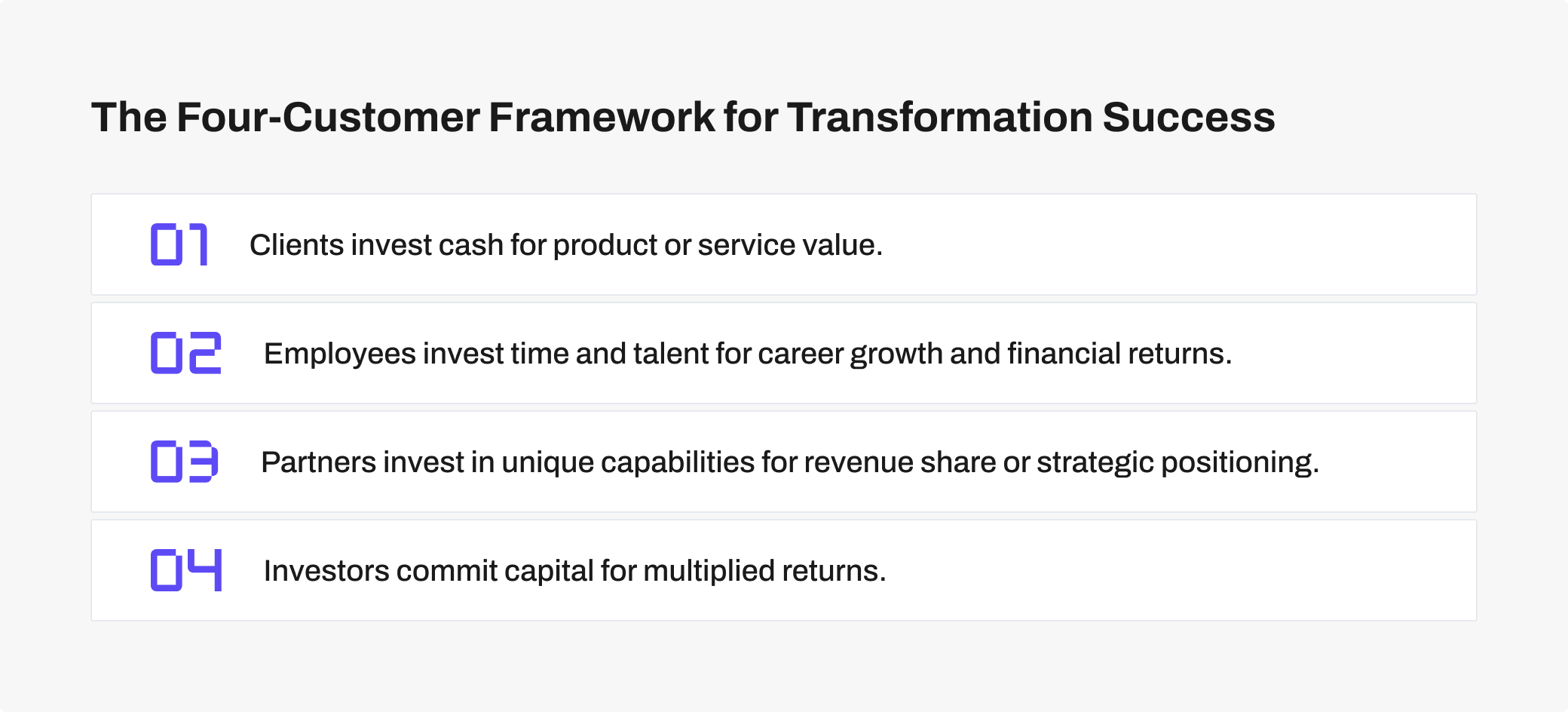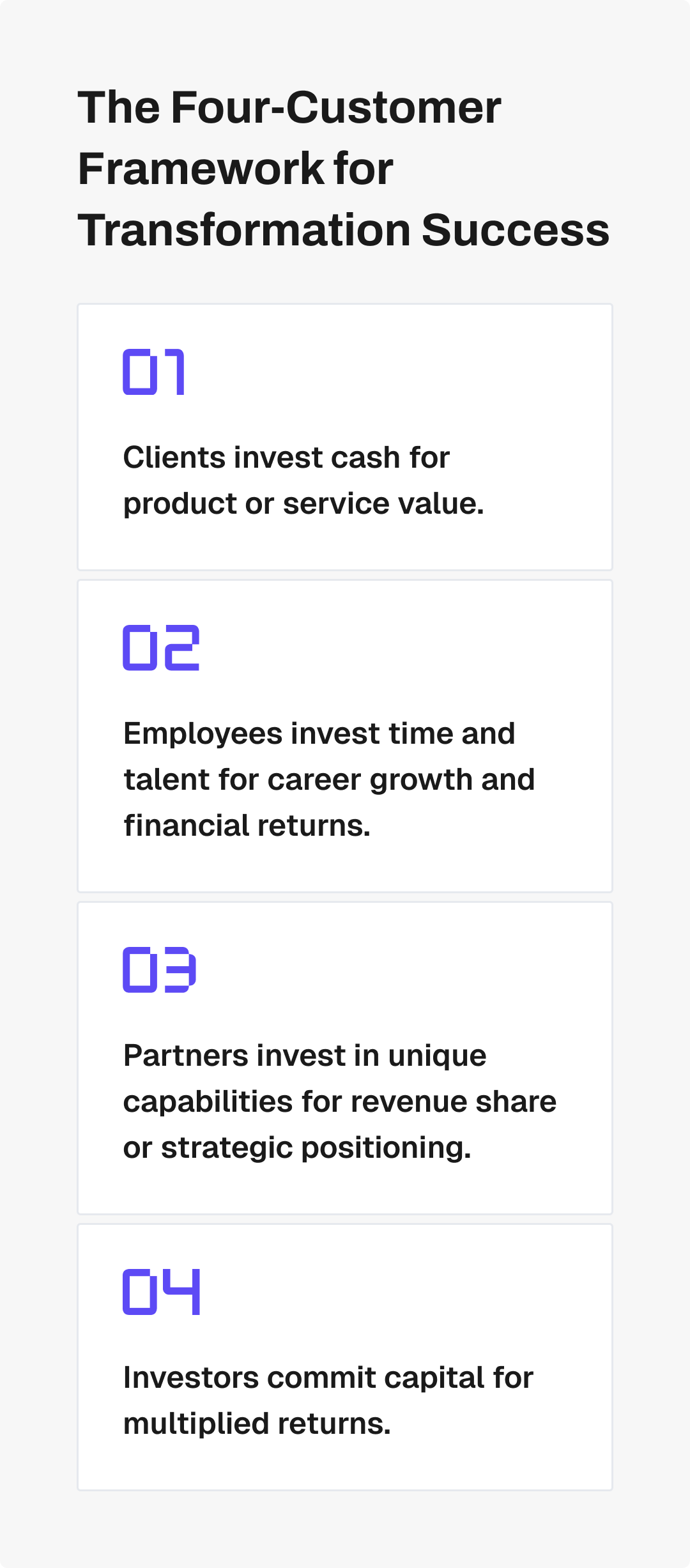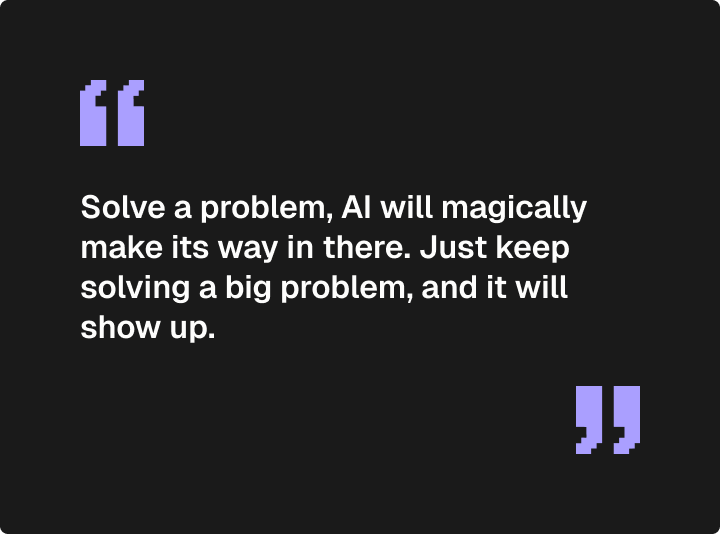The Four-Customer Framework That Unlocks Enterprise Value
Through 25 years of buying, building, and selling companies, Jeff Spence has seen the same story play out again and again. A private equity firm acquires a promising mid-market company. The executive team gets a budget and marching orders. And then the transformation crashes and burns.
The problem doesn’t always come down to the execution. Most business leaders approach digital transformation the way they were trained: optimize for the loudest voice in the room, deliver what customers request, stay within budget constraints, and measure success by EBITDA multiples.
This approach turns even sophisticated organizations into commodity providers fighting on price instead of value. Jeff has developed a framework that breaks this cycle by forcing companies to satisfy four distinct customer constituencies simultaneously. When one Scandinavian logistics company applied this thinking, an €8 million digital investment generated €150-175 million in value over five years. The transformation didn't just improve margins—it expanded what the business could sell and to whom.
The Budget Mindset That Caps Your Potential
Business education created a generation of executives who think tactically rather than strategically. Jeff traces the problem to its roots: "Our business schools were built and funded by large businesses that needed a whole bunch of people to do these things for them, but we don't think or function in that system anymore."
Those large corporations needed managers who could execute within defined parameters:
- Give someone a budget
- Watch them optimize spending
- Promote the ones who do more with less
The system works brilliantly for Fortune 500 companies that need thousands of people executing consistent processes. A mid-market company copying the same playbook often misses the fatal flaw.
When a CEO receives a budget allocation, that ceiling becomes their vision. "What I just told you is telling you I've capped what you can do, I've given you this limit," Jeff explains. The result: executives focus on executing assigned tasks rather than identifying transformational opportunities.
This budget-first mindset creates downstream problems that sabotage digital initiatives. Companies build solutions around customer RFPs instead of demonstrating real value through solving problems customers don't realize they have. "By definition, as soon as you do what I told you or asked you for, you're actually delivering a commodity to me," Jeff observes. Superior execution of commodity services still results in commodity pricing.
The same constrained thinking poisons relationships with investors. Without clear data, decisions default to whoever argues most persuasively.


15-20% of revenue
Cost of data quality issues
7 - 12
Disconnected systems
3-6 month
Delays just to get basic
reporting
Executives spend energy on internal politics instead of external value creation. The transformation budget becomes another battleground rather than an opportunity to expand strategic options.
The Four-Customer Framework for Transformation Success
Jeff's framework redefines how companies approach digital transformation by recognizing that businesses serve four distinct customer constituencies, each making a specific investment in exchange for specific returns.
- Clients invest cash for product or service value.
- Employees invest time and talent for career growth and financial returns.
- Partners invest in unique capabilities for revenue share or strategic positioning.
- Investors commit capital for multiplied returns.


"They're all customers. They all want something from us," Jeff states plainly.
Many digital transformations fail because companies optimize for just one group. A cost-reduction initiative might satisfy investors in the short term, but it alienates employees who see it as job elimination rather than enablement. A feature-rich product might delight some clients but overwhelm the sales team and create support nightmares that make the business less attractive to partners.
Jeff's approach demands simultaneous value creation across all four groups. When evaluating transformation projects, he pushes leadership teams to articulate specific benefits for each constituency.
→ How does this investment help clients solve bigger problems?
→ How does it enable employees to contribute their full expertise?
→ How does it create partnership opportunities that expand market reach?
→ How does it position the business for a higher exit multiple?
The aforementioned Scandinavian logistics company demonstrates this framework in action. Before their transformation, four profitable but disconnected transportation units operated in isolation. Clients could book marine shipping or rail freight, but not integrated multi-modal logistics for specialty cargo like refrigerated pharmaceuticals or scientific equipment.
The €8 million investment unified their data layer without replacing any of their individual systems. Marine, rail, truck, and last-mile operations maintained their existing tools but gained ability to share tracking information, coordinate hand-offs, and present clients with single contracts covering complex routes.
- For clients, this solved problems they couldn't previously solve—moving temperature-sensitive cargo across multiple transport modes with complete visibility.
- For employees, integration eliminated friction between departments and enabled them to contribute ideas for new service offerings.
- For partners, the data APIs opened opportunities to layer additional services onto the platform.
- For investors, the company shifted from commodity transportation to specialized logistics commanding premium pricing.
"You solve for one in a vacuum, it's gonna be myopic, temporary, and it's gonna ruin one of those connections to your other constituencies," Jeff argues. "If you solve for those four simultaneously, your solution is going to succeed."
The framework prevents the typical transformation pattern where one stakeholder group wins at others' expense. It forces difficult questions early about whether a proposed initiative actually creates broad value or merely shifts costs and benefits between groups.
Most importantly, it gives executives a clear standard for evaluating transformation proposals: Does this measurably improve outcomes for all four constituencies?
AI as Table Stakes: The Integration Imperative
Companies are making the same mistakes with their AI transformations that they made with previous technology shifts. They treat it as a distinct product category rather than a foundational capability that should permeate everything.
There’s a parallel to draw with earlier technologies. "We didn't say, ‘I am the telephone sales optimization company’,” says Jeff. “I'm a scheduling company. Of course I use a telephone." Yet businesses currently position themselves as "AI-powered" or build "AI solutions" as if the technology itself creates differentiation.
AI must become table stakes. "The winners aren't going to be the guys positioned as geniuses in AI. That’s a basic standard, just like you better be really good at video conferencing," Jeff explains. Companies that treat AI as a selling point today will find themselves explaining commodity offerings tomorrow.
The transformation opportunity lies in integrating AI throughout operations so thoroughly that it becomes invisible. Client-facing teams should use it to understand customer needs better than clients understand themselves. Employees should leverage it to contribute insights that would be impossible to surface manually. Partners should find AI-enhanced APIs that make integration frictionless. Investors should see AI-driven operational efficiency reflected in margins without anyone needing to highlight the technology.


The companies that will win aren't merely just building AI features. They're solving harder problems faster because AI enables approaches that weren't previously possible. That distinction matters more each year as the technology itself becomes commoditized.
The New Standard for Digital Investment
The gap between successful and failed digital transformations comes down to a single decision: whether executives optimize for one constituency or engineer value for all four simultaneously. The Scandinavian’s €150-175 million value creation over five years didn't come from cost optimization—it came from expanding what the business could sell and to whom.
This same principle applies to AI integration and every technology shift that follows. Companies that treat new capabilities as products rather than tools will find themselves explaining commodity offerings while competitors solve harder problems faster.
The winners understand that transformation succeeds when every stakeholder group can articulate how they benefit—and when executives can communicate that value in the language investors actually speak. Budget constraints matter less than strategic clarity. Technical sophistication matters less than truly anticipating and solving for unknowns. The four-customer framework doesn't just align stakeholders. It unlocks the enterprise value that budget-driven thinking leaves on the table.






Let's start with a diagnostic.
- Custom mapping of risks, integration points, and tech gaps
- Actionable follow-up playbook if there's a fit






